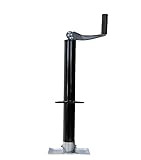Smooth Hauls Ahead: Choosing the Perfect Topwind Trailer Jack
A Topwind trailer jack is crucial for safely lifting and stabilizing your trailer during hitching, unhitching, and leveling. This device simplifies the process of raising or lowering your trailer to connect it to your vehicle or adjust its height. By providing reliable support and ease of use, a Topwind trailer jack enhances the safety and convenience of towing operations, ensuring your trailer remains stable and secure.
Weight Capacity
The weight capacity of a Topwind trailer jack is fundamental for safe operation. Select a jack with a capacity that exceeds the loaded weight of your trailer. For instance, if your trailer weighs 3,000 pounds, choose a jack with a weight capacity of at least 3,500 pounds to provide a margin of safety. This ensures the jack can handle the load without strain, reducing the risk of mechanical failure and ensuring stable lifting.
Construction Material
The material used in the construction of the Topwind trailer jack affects its durability, strength, and resistance to environmental factors. Steel jacks offer robust strength and are highly durable, making them suitable for heavy-duty applications. However, they can be prone to rust if not properly maintained. On the other hand, aluminum jacks are lighter, resistant to rust, and easier to handle, though they may not be as strong as steel. For frequent outdoor use, an aluminum jack with a powder-coated finish can offer both durability and resistance to weather conditions.
Crank Mechanism
The crank mechanism is essential for smooth and efficient operation of the trailer jack. Look for a jack with a well-designed, ergonomic crank handle that provides ease of use. A long handle with a comfortable grip allows for greater leverage, making it easier to lift heavier loads. Additionally, some jacks feature a gear-driven mechanism that provides higher lifting power with less effort, which is beneficial for lifting trailers with substantial weight.
Adjustability and Height Range
Ensure that the Topwind trailer jack has an adequate height range to suit different trailer sizes and ground clearance needs. Adjustable jacks with multiple height settings provide flexibility and accommodate various towing scenarios. Check the minimum and maximum height adjustments to ensure compatibility with your trailer.
Ease of Maintenance
Regular maintenance prolongs the lifespan of your trailer jack. Choose a jack that features accessible components for routine checks and maintenance. Some jacks come with rust-resistant coatings, sealed bearings, or protective covers that minimize maintenance needs and extend durability. A jack with easy-to-clean surfaces and lubricated moving parts can also reduce upkeep efforts and ensure smooth operation over time.
Stability and Design Features
Stability during operation is crucial for safe lifting and lowering. Look for a jack with a wide, stable base to prevent tipping or wobbling. Additional design features such as swivel bases or integrated stabilizers can enhance stability and make maneuvering easier. For example, a jack with a swivel base allows for easier alignment with the trailer’s hitch, while integrated stabilizers provide extra support and prevent movement during use.








































